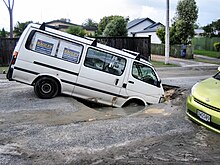In materials science, liquefaction [1] is a process that generates a liquid from a solid or a gas [2] or that generates a non-liquid phase which behaves in accordance with fluid dynamics. [3] It occurs both naturally and artificially. As an example of the latter, a "major commercial application of liquefaction is the liquefaction of air to allow separation of the constituents, such as oxygen, nitrogen, and the noble gases." [4] Another is the conversion of solid coal into a liquid form usable as a substitute for liquid fuels. [5]
Geology

In geology, soil liquefaction refers to the process by which water-saturated, unconsolidated sediments are transformed into a substance that acts like a liquid, often in an earthquake. [6] Soil liquefaction was blamed for building collapses in the city of Palu, Indonesia in October 2018. [7]
In a related phenomenon, liquefaction of bulk materials in cargo ships may cause a dangerous shift in the load. [8] [9]
Physics and chemistry
In physics and chemistry, the phase transitions from solid and gas to liquid ( melting and condensation, respectively) may be referred to as liquefaction. The melting point (sometimes called liquefaction point) is the temperature and pressure at which a solid becomes a liquid. In commercial and industrial situations, the process of condensing a gas to liquid is sometimes referred to as liquefaction of gases.
Coal
Coal liquefaction is the production of liquid fuels from coal using a variety of industrial processes.
Dissolution
Liquefaction is also used in commercial and industrial settings to refer to mechanical dissolution of a solid by mixing, grinding or blending with a liquid.
Food preparation
In kitchen or laboratory settings, solids may be chopped into smaller parts sometimes in combination with a liquid, for example in food preparation or laboratory use. This may be done with a blender, or liquidiser in British English.
Irradiation
Liquefaction of silica and silicate glasses occurs on electron beam irradiation of nanosized samples in the column of transmission electron microscope. [10] [11]
Biology
In biology, liquefaction often involves organic tissue turning into a more liquid-like state. For example, liquefactive necrosis in pathology, [12] or liquefaction as a parameter in semen analysis. [13]
See also
References
- ^ Some authors contend that there is a distinction between liquefaction and liquification (which is more commonly considered a misspelling), with the latter term applying only to processes involving heat. Knox, Ray; Stewart, David (1995). "3. Recognizing Seismic Landforms". The New Madrid Fault Finders Guide. Marble Hill, MO: Gutenberg-Richter Publications. p. 36. ISBN 978-0-934426-42-8. LCCN 91-91374.
-
^ "Pharmaceutical Processes: Processes of Liquefaction". The Pharmaceutical Era. No. 21. 20 April 1899. p. 503.
[by] a process of liquefaction is meant any process the effect of which is to cause a solid or gaseous body to assume or pass into the liquid state.
- ^ Pickett, Joseph P., ed. (2005). "Liquefaction". The American Heritage Science Dictionary. Boston, MA: Houghton Mifflin Company. p. 363. ISBN 978-0-618-45504-1. LCCN 2004019696.
- ^ Mavrikis, Peter; Horobin, Wendy, eds. (2003). "Liquefaction". How It Works: Science and Technology. Vol. 20 (3rd ed.). Tarrytown, NY: Marshall Cavendish. p. 64. ISBN 0-7614-7314-9. LCCN 2001028771.
- ^ Speight, James G. (2013). The Chemistry and Technology of Coal. Chemical Industries. Vol. 132 (3rd ed.). Boca Raton, FL: CRC Press. pp. 545–607. ISBN 9781138199224.
- ^ USGS. "About Liquefaction". Archived from the original on 2013-04-12.
- ^ Davis, Nicola. "Indonesia earthquake: soil liquefaction blamed for building collapses". The Guardian.
- ^ Gourvenec, Susan (2 September 2018). "Mystery of the cargo ships that sink when their cargo suddenly liquefies". Ars Technica. Retrieved 6 September 2018.
- ^ Marcolini, Barbara; Koettl, Christoph. "How the Indonesia Earthquake Made Soil Flow Like Water". NYT. No. International.
- ^ Möbus, Günter; Ojovan, Michael; Cook, Stuart; Tsai, Jim; Yang, Guang (January 2010). "Nano-scale quasi-melting of alkali-borosilicate glasses under electron irradiation". Journal of Nuclear Materials. 396 (2–3): 264–271. Bibcode: 2010JNuM..396..264M. doi: 10.1016/j.jnucmat.2009.11.020.
- ^ Zheng, Kun; Wang, Chengcai; Cheng, Yong-Qiang; Yue, Yonghai; Han, Xiaodong; Zhang, Ze; Shan, Zhiwei; Mao, Scott X; Ye, Miaomiao; Yin, Yadong; Ma, Evan (December 2010). "Electron-beam-assisted superplastic shaping of nanoscale amorphous silica". Nature Communications. 1 (1): 24. Bibcode: 2010NatCo...1...24Z. doi: 10.1038/ncomms1021. ISSN 2041-1723. PMC 3047011. PMID 20975693.
- ^ Robbins and Cotran: Pathologic Basis of Disease, 8th Ed. 2010. Pg. 15
- ^ Gardner, Kavid (2001). Textbook of Assisted Reproductive Technology Laboratory and Clinical Perspectives. Taylor and Francis. p. 63. ISBN 9780415448949. Archived from the original on 2014-01-02. Retrieved 2013-11-03.